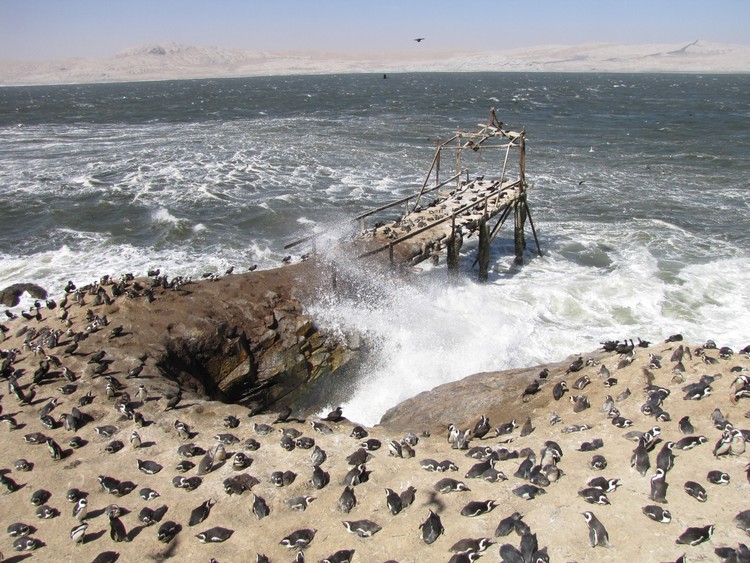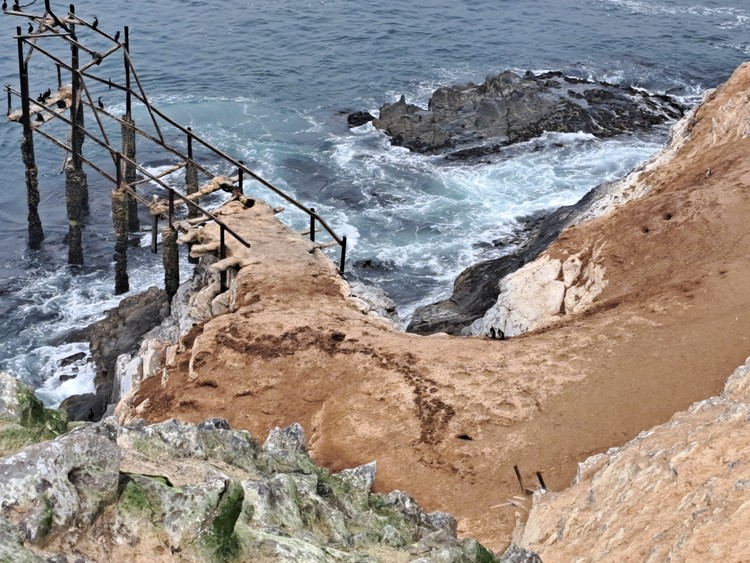Seal attacks contribute to African penguin’s looming extinction
Namibian breeding colonies decimated by predation
When this photograph was taken in 2009, Mercury Island off the Namibian coast had a thriving African penguin population. Today, there is not a single penguin on the island. Photo: Jessica Kemper
- If the African penguin population continues falling at current rates, the bird will be extinct in the wild in about 10 years.
- There were about 25,000 breeding pairs across their range eight years ago, there are now about 10,000.
- While overfishing is the main cause of their demise, seal predation has decimated the remaining colonies on Namibian islands, as well as populations of cormorants and gannets.
- Culling of rogue seals that hunt penguins, although controversial, may be needed for conservation efforts.
At the current rate of population loss, African penguins will be extinct in the wild in about ten years. But Yves Chesselet will feature as someone who prolonged their survival as long as possible.
He did so during an eight-year posting on the tiny island of Mercury off Namibia in the 1990s, by killing the seals that were killing the penguins and other endangered seabirds nesting on the 3ha outcrop of barren rock.
It was a strategy that would have been highly controversial if anyone had known about it; the need to cull seals to protect seabirds is an issue that many conservationists still avoid.
During his time on Mercury as a government conservationist — living alone but for the occasional company of a helper — Chesselet single-handedly drove off the seals that were encroaching on the breeding zones of penguins, Cape gannets, Cape cormorants, and bank cormorants.
His seal management crusade laid the foundation for what became a thriving penguin colony on Mercury, 90km north of Luderitz and 800m from the mainland.
“When Yves arrived there it was a carpet of seals,” says Dr Jessica Kemper, a member of the executive council of the Namibian Foundation for the Conservation of Seabirds (NAMCOB).
“He physically had to sjambok seals off the islands every day by the hundreds.”
Between 2015 and 2019, Mercury had between 2,300 to 2,600 penguin nests at peak breeding season, says Kemper.
But today, she says, there are zero. “Not. A. Single. One.”
The shocking population crash for penguins over the past five years is true also in varying degrees for the other three seabird species and for the other Namibian islands near Mercury, being Ichaboe, Possession, and Halifax islands.
Kemper and others say a factor in the collapse was the Namibian Ministry of Fisheries and Marine Resources (MFMR) withdrawal of full-time staff on the islands just before the Covid pandemic, due to budget constraints. Since then, seals have been left to their own devices.
The toll the seals are taking has been amplified by the fact that populations of the four seabird species – all endemic to the coasts of Namibia and South Africa - have declined dramatically over the past few decades because sardines and anchovies, which are their main food source, have been overfished.
Namibia’s sardine fishery collapsed in the 1960s and 1970s, and, despite a moratorium implemented in 2018, the fish have not returned in significant numbers.
“[Seabird numbers] have been hovering along on a relatively low number, it seemed to be the number that the system could sustain with the food there was,” says research manager at the Southern African Foundation for the Conservation of Coastal Birds (SANCCOB), Dr Katta Ludynia.
But Ludynia said when numbers were at a low level, it didn’t take much to push the population over the edge. She said this could be due to an avian flu outbreak - such as one causing the death of 600 penguins on Halifax island in 2019 - or “a few seals killing a few hundred birds”.
“Basically the sardine is the key to the entire northern Benguela ecosystem. You take out the sardines, you cause a whole lot of shit. Bringing back the sardine is the key,” said Kemper.
Additionally, Ludynia says SANCCOB suspects rogue seals are raiding the Namibian islands now that the government conservationists are gone. “A permanent human presence was actually good for the birds.”
She stresses not all seals are seabird killers.
“It’s very specific seals that learn this behaviour. So the headmen [government conservationists] would basically shoot this one individual seal and the problem would be solved. But if you don’t do that, then the one seal teaches the next seal and it just continues.”
Today, not a single penguin nests on Mercury Island. Seal tracks are visible on the sand in the middle of the photograph. Photo: Katta Ludynia
Chesselet says that as he approached Mercury Island to take up his post in 1991, “I could check, there’s the seabird colonies, and there’s the seal colonies just edging in, edging in. When I saw that, I thought: Hah, these seabirds haven’t got a chance in hell, the seals are just going to take over.”
He said conservation authorities had non-lethal protocols for dealing with problem seals.
“They told me what to do, and I realised very quickly: I’m sorry, you don’t deal with seals like that. Seals are a completely different animal.”
So, without telling anyone, Chesselet started killing new-born seal pups on the island every day.
“It’s what nobody wants to hear,” Chesselet says. “I knew I had to kill the pups. No pups, no mothers, no bulls. That’s the equation. It doesn’t work if you do it in any other fashion.”
The trauma of mass killing led to a nervous breakdown, and he had to be airlifted from the island to recuperate.
He’s bitter now that his efforts have been reversed over the past five years.
“All that hard work, almost killing myself in the process, and now suddenly there are unmanned islands … Unfortunately, you have to manage seals. You have to cull them.”
Wilfred Chevill, who leads seabird conservation efforts at Dyer Island off Gansbaai, agrees.
Chevill says he and his colleagues had been trying in vain for 15 years to get the seabird-conservation establishment to acknowledge the “devastation” that seals are wreaking on seabirds, and the message is finally getting through.
“It’s happening massively at Dyer Island. When the cormorants fledge in December, there are thousands in the water. The seals predate on them and once the cormorants are gone, the only guys left in the water are the penguins and then they go for the penguins.
“These same seals, they go out in the ocean and predate massively on gannets roosting on the water. The rogue seals are a massive problem.”
The answer, he says, is constant vigilance. “If you see a seal predating, take it out. We don’t have a shortage of seals, we have a shortage of seabirds.”
Dr Judy Mann, head of strategic projects at the Two Oceans Aquarium Foundation, says seal predation is “something we try not to talk about. We’re very happy to talk about the conflict between fishing and all the rest of it, but we don’t talk about the conflict with seals, and I think that’s a very real issue and that’s something that in the penguin conservation world we should be talking about more.”
Mann notes that seal populations along the Namibian and South African coasts are thriving.
“These are wicked problems. In order to save penguins, should we cull seals? To save penguins, should we decrease fishing? What is the impact of decreasing fishing on people? Does one species carry more weight than another?” says Mann, noting these are complex philosophical questions.
Both Kemper and Ludynia contributed to a paper recently published in Ostrich, the journal of African ornithology, recommending the International Union of Conservation of Nature move the African penguin from “endangered” to “critically endangered”.
This will probably happen in October, says Ludynia, making it the first penguin to be declared critically endangered.
“It’s a big warning sign,” says Kemper. “Hello guys, we need to really make a plan … because once they’re gone, they’re gone.”
One of the things NAMCOB wants to do is place rangers back on Mercury, Ichaboe and Possession islands, but getting government clearance has been a hurdle, says Kemper.
“These guys have been appointed. They’ve undergone basic training … they are chomping at the bit, but there is still so much to sort out. And now the infrastructure on Mercury has completely crumbled in the absence of anyone doing maintenance.”
But whether the penguins will come back even if rangers are appointed on the islands, is “the million-dollar question”, says Kemper. “Are there penguins that would be there if they weren’t disturbed by seals every single day, or are they simply gone? We simply don’t know. It’s frightening.”
Ludynia says the Namibian islands are — or were — “super important” for all four endangered seabird species.
“Before the population crash of Mercury Island, we had St Croix Island in Algoa Bay, which was the world’s biggest African penguin colony — that has now crashed since 2016. Mercury at that point would have been deemed the world’s largest population, but now it has also crashed.”
Kemper says penguin numbers have plummeted from about 25,000 breeding pairs for Namibia and South Africa combined eight years ago to just 10,000 now.
BirdLife and SANCCOB say the species could go extinct in the wild by 2035.
The decline of the bank cormorant is also dramatic. Ludynia says Mercury at one point had 1,500 breeding pairs, which was estimated to be 80% of the world population. Now there is just “a handful”.
Kemper said gannets are also in dire straits, with only about 200 pairs left on Possession island. “In the counts [late last year] there was not a single gannet on Mercury. We have no idea what’s happened. [On] Ichaboe, the population is probably between 7,000 and 9,000 pairs but is shrinking, shrinking, shrinking.”
Desmond Tom, the seabird scientist for Namibia’s MFMR, says the ministry is “very much concerned” about seabird numbers.
“Seal predation is coupled with other factors in the decline,” says Tom. The MFMR plans to recruit two people to be stationed at Ichaboe and Mercury, together with rangers from NAMCOB, “to continue with monitoring and seabird rehabilitation work on the islands as well as in Luderitz”.
Tom says a marine protected area that runs 400km along the southern Namibian coast, stretching 30km offshore, was proclaimed in 2008 to protect fish stocks for seabirds. “However, the management plan and regulations are under review to strengthen its entire objective. The MPA is a work in progress.”
Chesselet now works for CapeNature at Lamberts Bay, where he protects the gannet colony on Bird Island from seals. The seals do not raid the nests, he says, but when the chicks enter the water it’s a bloodbath.
“It’s completely out of hand” he says. “There’s too many seals, there’s too many people, there’s too much overfishing.”
Support independent journalism
Donate using Payfast

Don't miss out on the latest news
We respect your privacy, and promise we won't spam you.
© 2024 GroundUp. This article is licensed under a Creative Commons Attribution-NoDerivatives 4.0 International License.
You may republish this article, so long as you credit the authors and GroundUp, and do not change the text. Please include a link back to the original article.
We put an invisible pixel in the article so that we can count traffic to republishers. All analytics tools are solely on our servers. We do not give our logs to any third party. Logs are deleted after two weeks. We do not use any IP address identifying information except to count regional traffic. We are solely interested in counting hits, not tracking users. If you republish, please do not delete the invisible pixel.


